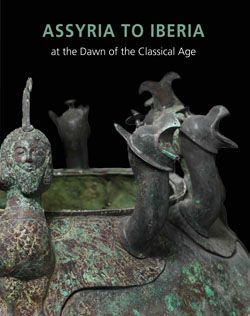Furniture plaque carved in relief with two falcon-headed sphinxes trampling captives
Not on view
This fragmentary, rectangular plaque is carved in low relief with two falcon-headed sphinxes, hybrid creatures that combine the body of lion with the head and wings of a falcon, trampling two fallen, bearded male figures. While the head of the sphinx on the right is not preserved, it was probably a falcon head crowned by a sun disc like the sphinx on the left. Found in a large storeroom at Fort Shalmaneser, a royal building at Nimrud that was probably used to store tribute and booty collected by the Assyrians while on military campaign, the preserved tenon projecting from the left edge of this piece suggests that it may have originally been fitted into a frame, likely as part of a piece of furniture. Several elements, including the falcon head, nemes cloth (a royal, pleated headdress), solar disc crown, and wesekh broad collar with pendant droplets, are drawn from Egyptian art and suggest that this piece can be attributed to the Phoenician style. The male figures wear long, belted and pleated robes, rest on their left elbows, and bend their legs at the knee with their heads sharply turned to the right by the paws of the sphinxes above them. Their heads are wrapped with thin cloths and their hair terminates in one straight and one curling sidelock. In Egyptian art, the image of a hybrid creature trampling captives is associated with the triumph of the Pharaoh over his enemies. However, the meaning in this context is unknown, since this piece was not made for an Egyptian audience.
Built by the Assyrian king Ashurnasirpal II, the palaces and storerooms of Nimrud housed thousands of pieces of carved ivory. Most of the ivories served as furniture inlays or small precious objects such as boxes. While some of them were carved in the same style as the large Assyrian reliefs lining the walls of the Northwest Palace, the majority of the ivories display images and styles related to the arts of North Syria and the Phoenician city-states. Phoenician style ivories are distinguished by their use of imagery related to Egyptian art, such as sphinxes and figures wearing pharaonic crowns, and the use of elaborate carving techniques such as openwork and colored glass inlay. North Syrian style ivories tend to depict stockier figures in more dynamic compositions, carved as solid plaques with fewer added decorative elements. However, some pieces do not fit easily into any of these three styles. Most of the ivories were probably collected by the Assyrian kings as tribute from vassal states, and as booty from conquered enemies, while some may have been manufactured in workshops at Nimrud. The ivory tusks that provided the raw material for these objects were almost certainly from African elephants, imported from lands south of Egypt, although elephants did inhabit several river valleys in Syria until they were hunted to extinction by the end of the eighth century B.C.
This image cannot be enlarged, viewed at full screen, or downloaded.


